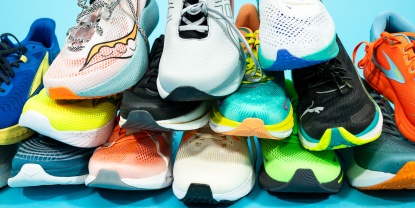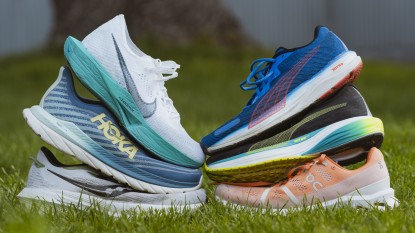Vibram V-Run Review
Our Verdict
Our Analysis and Test Results
Hands-On Review
We find the Vibram FiveFingers V-Run is a good running shoe for those looking for a barefoot shoe with a little more grip and padding than the more stripped-down models.
Responsiveness
The V-Run has an extremely thin EVA midsole at 4mm and XS Run rubber outsole at 2.5mm, giving the shoe an overall malleability. But when pressed between the foot and ground, the two soles are quite firm and in stride provide a sort of responsiveness. But that is obviously very different from a traditional shoe whose stacks of rubber or foam might provide a certain amount of give and return bounce.
Runners interested in more traditional shoes with similar features — limited, malleable soles and low heel-to-toe discrepancies — might take a look at the Brooks PureFlow 6 and the Nike Flex Fury 2. The PureFlow 6 has a considerable amount of padding and a bit of a padded heel, but there are only 4mm of difference between the heel and forefoot, which gives it a more natural feel without sacrificing most of the cushioning of the out and midsole, as in the V-Run. The Nike Flex Fury 2 offers less padding in the upper, but 1mm more in heel-to-toe discrepancy at 5mm and has a slightly firmer heel than the PureFlow 6. At this point, it comes down to preferences on other matters, such as comfort and preference for heel-to-toe drop. But the general suggestion is, if a barefoot shoe simply does not offer the responsiveness you are looking for, but you like the overall feel of a barefoot shoe, go with the Brooks PureFlow 6 — it earned the Editor's Choice award for a reason.
Landing Comfort
Though this is a barefoot shoe and it offers very little in the way of cushioning, Vibram did a fairly good job of placing their XS Run rubber pads along the strike points of the outsole — the toes, the ball of the foot, and beneath the heel in much the same configuration as the Nike Flex Fury 2, whose reinforced rubber pods serve to absorb and disperse shock in the same high-impact areas. Combined with the Vi-Lite insole, the shoe offers a surprisingly nice landing. Unlike the Spartan landing of the V-Run, the Flex Fury 2 gives a padded landing, but it retains much of the natural connection to ground so appealing to Vibram runners. Those not ready for the transition to Vibrams might consider the Flex Fury instead.
If you are not quite ready for a true barefoot shoe, but like the idea of limited heel-to-toe drop, we suggest you check out the Saucony Kinvara 8 whose style, though heavily padded, offers less heel-to-toe a near zero drop than the Flex Fury 2, but also provides a healthy bit of padding with its thick, uniform stack. This shoe certainly has a more comfortable landing and will hit the legs and ankles similar to the V-Run while sparing your body some of percussive impact of a barefoot shoe or a bare foot on the pavement. Understand that most traditional shoes will be somewhat more padded in their landing, but that does not always translate to comfort and is not always what feels right in a gait. A forefoot runner in a very comfortably-padded shoe that forces the runner to land farther back can create a very uncomfortable gait. And a massive shoe like the Hoka Clifton 3 might be low-weight and more responsive, with a low heel-to-toe discrepancy, but it can still be much less comfortable to run in than a sleek, skin-tight barefoot shoe for some runners. For the runner looking for a natural run, we suggest going with the Vibram V-Run.
Upper Comfort
The V-Run upper features an anti-microbial Drilex sockliner and stretchy polyester lycra mesh with polyester microfiber that feels like a second skin, which is the intention. While this upper feels mostly great, there are a number of issues in the design mentioned previously, which is why it received a good score but did not rank as high as some of the traditional shoes like the Nike Flex Fury 2. The Vibram V-Run design might work very well for a typical foot, but for runners with a longer second toe or a low pinky toe (where the pinky toe ends just above where the next toe starts), the design can feel something like chronically droopy shorts without a belt. Overall, the insole hugged the arch and the soft Drilex sockliner felt great on the bare foot, but Vibram does offer a line of toe socks to fit the shoe.
The upper is meant to be an exercise in stoicism and utilitarianism. In many ways Vibram is a reaction to complex shoes with all sorts of complicated feats of engineering rendering structural support and yielding performance advances. Vibrams are stripped down, basic, protective shoes, and their uppers are very utilitarian indeed. Again returning to the most comparable models, the Nike Flex Fury 2, and Brooks PureFlow 6: If you are after upper comfort, you simply cannot pass by the PureFlow 6, whose upper is made of pillows and sheet cake. If you need a more comfortable shoe, but don't want to spoil yourself completely, the Nike Flex Fury 2 is still a very comfortable ride and ranks just below the PureFlow 6, but well above the V-Run.
Breathability
The polyester lycra stretch mesh upper is also pock-marked with ventilation holes that add to its breathability, but the mesh itself is very thin, adding to its airy feel. For this reason the Vibram FiveFingers V-Run earned a top score in breathability, alongside the Saucony Kinvara 8, Nike Flex Fury 2, Brooks PureFlow 6, and the Brooks Glycerin.
Weight
The Vibram FiveFingers V-Run is the absolutely lightest shoe in our lineup, but its status as a barefoot shoe makes it barely fair to compare to the other shoes. Needless to say, the V-Run earned a top score here at 9.9 ounces for a pair of men's size 11. The next nearest competitors in weight were the Saucony Kinvara 8 at 16.9 ounces a pair and the Nike Flex Fury 2 at 17.2 ounces a pair, followed by the Hoka Clifton. It doesn't get much lighter than the V-Run without going full nude.
Durability
The Vibram V-Run will likely last a season or maybe a few if you don't put in a ton of abuse. We saw a degree of superficial degradation along the outsole and recognize that the the thin upper is more vulnerable to compromising tears than some of thicker shoes. We therefore gave them a good score, but not a top score. A more durable running shoe with comparable features is the Brooks PureFlow 6, though the PureFlow 6 still features a 4mm heel-to-toe discrepancy.
Best Applications
Given the well-placed tread along the outside, we found that the V-Run was a fairly versatile shoe that did equally well on steep rocky trails as on the road.
Value
At $130 a pair, we feel that this is a good buy for those ready to make the barefoot transition or looking for a pared-down, versatile barefoot running shoe. Not only is it worth it for the fact of its being a unique shoe to take out on the road, but it performs very well on trails and gives the right amount of protection for you would-be barefoot walkers in public.
Conclusion
We really like the Vibram FiveFingers V-Run, but recognize that running more than a few miles on the road or sidewalk without cushioning is not for everyone. For the committed barefoot runner, we highly recommend the shoe, though it might be worth trying a few different sizes in a store to see if a smaller or larger size works better with your toes, especially if you have strange, amorphous, many-times-broken toes like this author. We might finally suggest that you look at getting a pair for shorter runs, trail runs, or runs where there is enough grass alongside the running path to get in some good padded running. Or maybe look to a zero or minimal drop shoe like the Saucony Kinvara 8 or Altra Torin 2.5 (which also has limitations for long second toes) for longer runs in the eight or 10-mile range.









